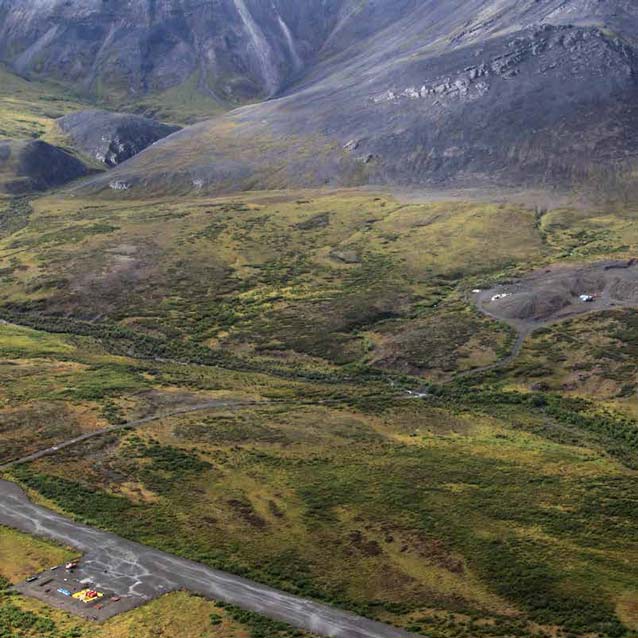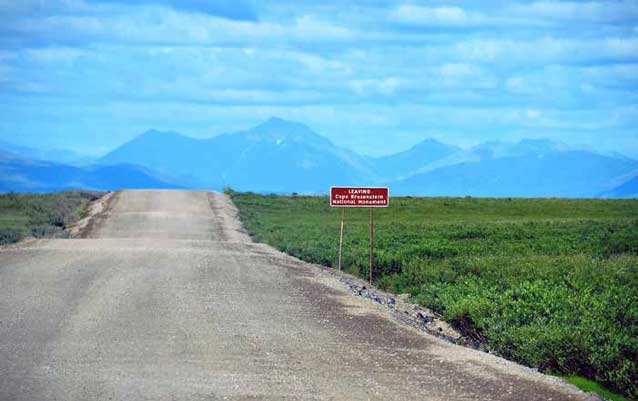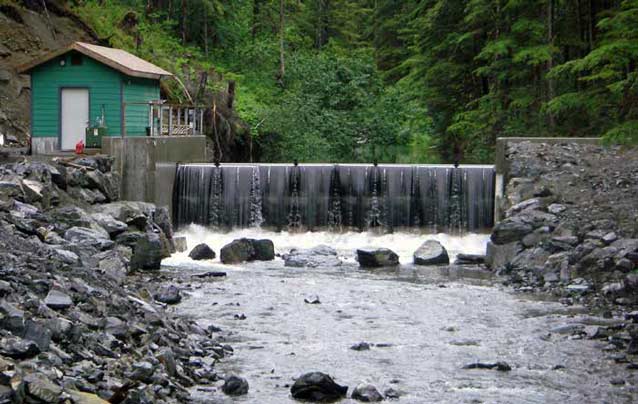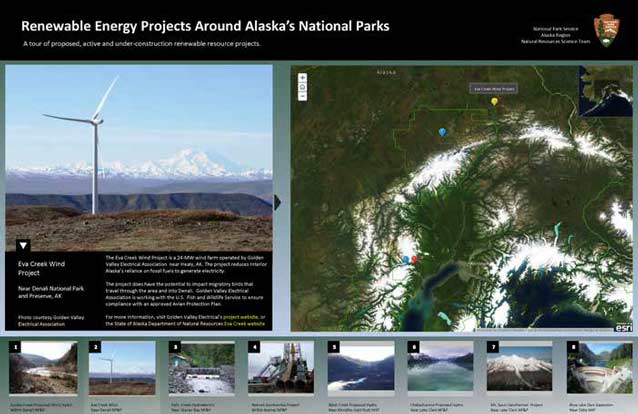
Ground Truth Trekking, Creative Commons Use License
Development History
Alaska is a state inextricably linked to both resource development and wilderness. It includes vast tracts of federally protected land, large and intact natural systems, abundant economically viable resource development prospects, and relatively few residents. Since the late 19th century, visitors have flocked to places like Glacier Bay to experience a connection with the landscape. Yet concurrent with the discovery of Alaska’s scenic and wilderness resources, visitors to the state discovered gold and other mineral resources. Development of these resources was instrumental in shaping modern Alaska. A careful balance between conservation and resource development continues today.
The legislative history of Alaska shapes current resource development on Alaska’s national park lands. The majority of Alaska’s national park units were designated under the Alaska National Interest Lands Conservation Act (ANILCA) in 1980. Many of the lands designated for conservation in ANILCA are adjacent to mineral and oil resources. Additionally, a significant amount of land within park unit administrative boundaries was selected and conveyed to Alaska Native Regional Corporations, including surface and subsurface rights (Gilbert, in this issue). Inholders within new conservation units possess certain rights, including development of any valid mining claims subject to National Park Service (NPS) regulation, and reasonable access to private property. ANILCA also made other unique provisions to allow for future development through the new park units; notably, when Congress designated Gates of the Arctic National Park and Preserve, it made allowances for a future road development across the preserve to access significant mineral deposits to the west (Gilbert, in this issue).
Many resource development projects within and outside of NPS administrative boundaries of various scales create the potential to affect or impact park resources, either directly or indirectly. Several of these projects would be significant in scale and require major infrastructure development to support their operations, while others are small, and likely or documented to have no significant impact.
The National Park Service has created a database and visual mapping interface that will allow land managers, visitors, and the public to more easily understand the type, scale, and scope of resource development adjacent to parks. The database and map include both the actual development locations and supporting infrastructure such as roads, ports, pipelines, and transmission lines.

Jim Dau
Background
Since 2010, the Western Arctic National Parklands (WEAR: Kobuk Valley National Park, Noatak National Preserve, Cape Krusenstern National Monument, and Bering Land Bridge National Preserve) have maintained a map of active and potential resource development projects in the region for management use. Decades of mineral exploration adjacent to WEAR are now culminating in proposed road corridors and new infrastructure. WEAR was interested in maintaining the map to allow resource managers to stay apprised of projects and their potential effects on park resources, including subsistence, visitor experience, wildlife populations and migration, and water and air quality. Aside from the 25-year-old Red Dog zinc and lead mine, the vast expanse of northwest Alaska remains relatively pristine.
The WEAR initiative was the basis of the current Mineral and Energy Development web mapping project. Conceptually, the map is a tool to allow park management to track and visualize the various projects by type of development, project activity status, resource type, and other attributes. It will allow users to view broader spatial patterns in projects by attributes of interest. The data will be available in three formats—as a web map; as a story map based on the web map with a more focused thematic approach, text descriptions, images, and links to external resources; and as a database.
Geodatabase
The database is the repository of project information, from which the data displayed on the web map and story maps are extracted. It is the most inclusive and versatile in terms of content and capability for data analysis and reporting. On request, the database can be shared with users interested in working directly with the data in ArcGIS.
The type of information captured in the database was determined with input from Alaskan park resource managers and environmental compliance specialists. A set of fields identifies the park resources potentially affected by the project, and the park’s level of concern.
Data held in the geodatabase can be broadly divided into information about potentially affected parks and park resources; project timelines and status; project ownership, management, and land ownership; environmental compliance information; external data links; and geospatial metadata. The database can store an image of each project or potential project area, if available.

Marci Johnson
By nature, these development projects are subject to change. The database maintains a timestamp of each feature’s last update date. Links to external resources such as project websites, projects’ National Environmental Policy Act (NEPA) compliance websites, and agency websites allow users to keep up-to-date between database updates, and find pertinent information such as open comment periods. Some of these resources, such as the internal NPS NEPA site Planning, Environment and Public Comment (PEPC), may be for internal viewing only and require an NPS login.
Each feature may also have its visibility or reproduction rights restricted based on relevant source restrictions. For example, if a project is in a preliminary planning stage and a park doesn’t feel that the available data has been vetted enough to appear on the map yet, it may be omitted. If geospatial data was acquired from an outside source, any associated use restrictions may be included.
Web Map
A web map is a way for users without GIS software to browse and explore GIS data sets and base maps in a web browser. Thematic subsets of data are taken from the developments database, symbolized, and added to maps. Users can pan and zoom on the map, and click on a feature to view a pop-up window displaying its attribute data.
Story Map
Story maps are based on web maps. Story maps enable the viewer to view an interactive map of projects, divided into themes. Unlike web maps, they may contain descriptive sidebars linked to each project, with multimedia and text descriptions of the data for a less technical feel. Links to external resources may be included. This product is the most interpretive and is useful for project summaries.
Resource Development Projects
Approximately 70 resource development projects were identified as being of interest to park management, including dependent infrastructure projects. Of these projects, the owners or operators of 78 percent of the projects have expressed intent to pursue exploration and eventual development, or are already doing so. The remaining 22 percent of projects are inactive, or have been recently abandoned or reclaimed. Approximately 15 percent of projects are already actively producing or in construction phase. Following are two examples.

NPS Image
Example: Red Dog Mine in Cape Krusenstern
The largest active mineral development that has been documented to affect Alaskan park resources, the Red Dog zinc deposit was identified in the 1970s and explored from 1980 to 1981. A road to water was required to export ore; the U.S Environmental Protection Agency determined that an economic impact statement (EIS) would be necessary. The EIS was completed from 1981 to 1984 and concluded that the road option with the least environmental impact passed through Cape Krusenstern National Monument.
An agreement was reached between NPS, NANA Regional Corporation, and Cominco (now Teck) in 1986. This road corridor through Cape Krusenstern required congressional modification of the Alaska Native Claims Settlement Act (ANCSA) and an easement through the park conveyed by the Secretary of Interior (Cocklan-Vendle and Hemming 1992).
Monitoring in the early 2000s identified that fugitive dust along the road was resulting in deposition of cadmium and lead into Cape Krusenstern National Monument. Subsequently, the mine changed its ore concentrate transportation trailers to reduce fugitive dust, and re-designed its concentrate transfer facility. The mine now has a Fugitive Dust Risk Management Plan and is continuing to work on reducing fugitive dust.
Approximately 15 million gallons of fuel are stored on site near the port. The fuel is transported from offshore tankers. Barges are also used to haul ore concentrates from the port to larger vessels in deep water offshore. However, relative to other activities in the Bering Strait vicinity, the NPS concern for marine activities at the Red Dog mine is low. The mine has the primary response capabilities in the northwest arctic, has a state-approved oil spill response program, and conducts regular response drills.
Approximately 12 miles (19 kilometers) northwest of the Red Dog mine, the Lik Deposit was staked in 1976. Test drilling has delineated an ore body, which the claimant is interested in developing. The Lik Deposit development would be much less economically viable without its proximity to Red Dog. Preliminary plans indicate that the Lik development would share the Red Dog road and port facility, and have lower operating costs by sharing maintenance and port operation fees. Development of the prospect would result in potential increased impacts to the road, expansion of the port, greatly expanded fuel and ore storage capacity, increased vessel traffic, and other necessary growth to support operations (Matter et al. 2014).

NPS Image
Example: Mining within Wrangell-St. Elias and Hydropower Near Glacier Bay
The Mining in the National Parks Act of 1976 established conditions under which mining can occur within national parks. In Wrangell-St. Elias National Park and Preserve, active placer mining does occur in two areas. In the Chisana district, mining has occurred on some claims for nearly 100 years. Current mining is taking place on previously disturbed areas with relatively low-impact methods.
Other projects, such as renewable energy projects, have been supported by NPS, address climate change, and increase sustainability. One such example is the Falls Creek hydroelectric project near Glacier Bay National Park and Preserve. The Secretary of Interior and State of Alaska agreed upon a land exchange that transferred land from Glacier Bay wilderness in order to build a hydroelectric power plant to supply the community of Gustavus. In exchange, an equivalent acreage of new wilderness was designated in Glacier Bay, and NPS acquired an equivalent amount of land from the State of Alaska within Klondike Gold Rush National Historic Park. This decision involved years of study, an environmental impact statement, and record of decision. The project has greatly reduced the dependency of the gateway community of Gustavus on diesel. Glacier Bay is now investigating ways to connect to the renewable energy resource and reduce its own use of fossil fuels.
Summary
The Red Dog mine is an example of how park awareness of development issues and engagement with regional development projects resulted in a better outcome for park resources. Other projects continue to operate within parks in compliance with NPS regulations and result in no significant impacts to park resources. Continued awareness of activities surrounding NPS units will enable NPS managers to act as better park stewards and more informed neighbors in this largely undeveloped state. This user-friendly database and map allows for easy display and understanding of the scale and scope of resource development near parks.
References
Cocklan-Vendle, M., and J.E. Hemming. 1992.
Regulatory Processes Associated with Metal-Mine Development in Alaska: A Case Study of the Red Dog Mine. U.S. Bureau of Mines Open-File Report 93-92.
Gilbert, C. This issue.
Land Ownership in National Park System Units in Alaska and Possibilities for Mining and Other Developments.
Johnson, M. 2013.
Northwestern Alaska Development Map. National Park Service unpublished map. Kotzebue, AK.
Matter, R.L., T. Loschiavo, G. Rawsthorne, N.N. Gow, and M. Travis. 2014.
Preliminary Economic Assessment Technical Report, Lik Deposit, Alaska, USA. Prepared for Zazu Metals Corporation. JDS Energy & Mining, Inc. Vancouver, B.C.
National Park Service. 2006.
Record of Decision: Falls Creek Hydroelectric Project & Land Exchange. National Park Service. Gustavus, AK.
Part of a series of articles titled Alaska Park Science - Volume 13 Issue 2: Mineral and Energy Development.
Last updated: June 15, 2015
